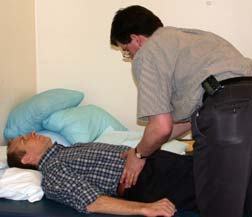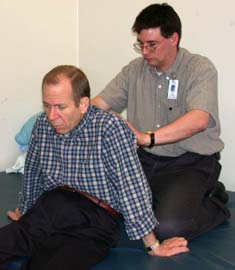Choosing a Wheelchair
Wheelchair seating evaluation has come a long way in the past decade. Not long ago, wheelchair choice was very limited. "Now, choosing your wheelchair is a very individual and personal decision, with many choices," says Kirk Hennig, who has a C6 SCI and recently decided to replace the manual wheelchair he has used for 14 years.
Finding a wheelchair that fits the physical, lifestyle and financial needs of the user begins with a thorough seating evaluation by a clinician who specializes in seating and positioning and who can guide the consumer through this often confusing and time-consuming process.
The goals of optimal wheelchair seating include protecting skin integrity; optimizing function and independence; and creating or maintaining normal anatomic alignment, with particular attention to the spine. 1 Since obtaining a properly fitting wheelchair can often take three-to-six months, it makes sense to be proactive and initiate the seating evaluation process before pain develops or skin or posture changes arise from a poorly fitting chair.
For newly injured individuals, seating evaluation begins during inpatient rehabilitation. The first wheelchair is usually suitable for several years with only minor modifications, unless there is a dramatic decline in medical status, a considerable change in growth (as in the case of a child) or a significant weight gain or loss.
Hennig's search for a new wheelchair began with an outpatient visit to his doctor, who was concerned about some skin and postural changes and referred him to the seating clinic at Harborview Medical Center. There he was evaluated by Dave Colescott, a physical therapist who specializes in seating and positioning.
Colescott takes a comprehensive approach to seating evaluation, gathering information about a client's personal goals and expectations, medical and surgical history, social and living situation, daily routines, recreational activities and insurance coverage. Often Colescott must strive to find a balance between the health care needs and the personal goals of each client. This was the case for Hennig, who wanted a manual wheelchair that would be light enough for him to fold up and place in the back seat of his car, but stable enough that he would be able to safely manage his own transfers.
Insurance coverage significantly influences the final choice of equipment. "You often have to make the best of (the insurance coverage) you are working with in a fee-driven health care system," Colescott says. "Many clients simply do not have the financial resources to obtain the 'ideal' wheelchair."
In the first evaluation visit, Colescott examined Hennig's neurological status and spasticity, as well as the range of motion of his legs, pelvis, and spine. He gave Hennig a detailed physical assessment in both the sitting and supine positions and made several measurements (see Figures 1 and 2). He then observed Hennig's transfer and propulsion techniques before evaluating his sitting position with the pressure mapping system.
 |
 |
| Figure 1 & 2: Physical therapist Dave Colescott takes several measurements, including hip width, back length and leg length, to ensure a proper fit for Hennig's new wheelchair. | |
Pressure mapping is a relatively new addition to the seating evaluation process and is recommended for people at risk for skin breakdown, such as those who lack sensation in their buttocks and lower legs due to paralysis. A pressure mapping system consists of a computer, a single or multi-sensor pad, an electronics box, calibrations hardware, special software and a power supply. These systems digitize the pressure information taken while the patient sits on a thin bendable pad of sensors placed on top of the seat cushion. The numbers and colors on the computer screen correspond to a pressure reading: blue signifies low pressure and red shows high pressure, indicating danger to the underlying skin. 2 (See Figure 3.)
 |
Figure 3: Pressure map images reveal areas of high (red) and low (blue) pressure on the buttocks while seated. In this example (not Hennig's pressure map image), high pressure over the ischial tuberosities is greater on one side. |
Pressure mapping was originally developed for research purposes. Now clinicians use it to help make decisions about comfort, pressure ulcers or product differences. The system costs around $8,000, not including the computer; costly, but far less expensive than a single flap surgery (to treat a severe pressure ulcer). 2 Pressure mapping can provide dramatic visual feedback about proper seating and sleeping positions and effective pressure relief techniques. (Note: These systems only measure vertical or straight down pressure and do not capture shear (side-to-side) forces, which also contribute to pressure ulcers.) Pressure mapping can also be used to justify to an insurance carrier the need for an expensive seat cushion.
In Hennig's case, pressure mapping revealed increased pressure over the sacral region, which coincided with the observed posture of sacral sitting and forward bending of the trunk. Colescott felt Hennig needed a chair that would correct this posture by positioning his pelvis properly in a neutral alignment and supporting the curvature of the spine.
After the initial evaluation, the number of follow-up visits varies by individual. Several appointments may be necessary to try out different wheelchairs. Researching wheelchair options ahead of time on the Internet, at medical equipment stores, or by talking to other wheelchair users with SCI can help speed the selection process. Hennig's final choice of wheelchair was an ultra-light model that corrected his postural problems while satisfying his lifestyle priorities.
To obtain insurance payment for a wheelchair, the clinician must submit a lengthy justification letter with the equipment order. First requests are often approved. If they are denied, however, they require appeals and additional justification letters. Once approved, delivery usually takes four-to-six weeks.
The wheelchair market is a complex, competitive and continuously evolving industry. Through consumer demand and knowledgeable practitioners, the market is beginning to respond to the requests of wheelchair users. Ultimately, this leads to better products and healthier, more comfortable consumers.
- Debra Glazer, PT, MPH
(Seating evaluations are available at Harborview and UW Medical Centers, and Children's Hospital and Regional Medical Center, with a physician's referral.)
References-
1. Hastings JD. Seating Assessment and Planning. Topics in Spinal Cord Medicine 2000 Feb;11(1):183-207.
2. Krizack M. Portable Interface Pressure Mapping Unit Could Save Lives Around the World. Disability World, Aug-Sept 2000;4. http://www.disabilityworld.org/Aug-Sept2000/tech/IPM.htm (5/6/03).






